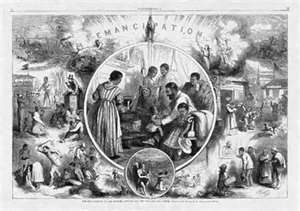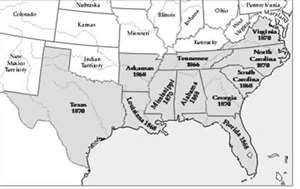The Struggles Surrounding Reconstruction
Reconstruction was a plan for rebuilding the states of the Confederacy, readmitting them to the Union, and providing for new and expansive rights for people formerly enslaved. Reconstruction took several forms and had many adherents and many opponents. Begun by President Abraham Lincoln, it was ended by President Rutherford B. Hayes.
An example of Lincoln's measured approach was the Ten Percent Plan, which stipulated that only 10 percent of the electorate had to take an oath of loyalty to the federal government in order for the state to be readmitted into the Union and, by extension, Congress. The first three states to benefit from this plan were Louisiana, Arkansas, and Tennessee. In a sign of the growing rift in Congress over how quickly to implement Reconstruction and how harshly to deal with secessionist states, Congress refused to count any votes from those three states. The so-called Radical Reconstructionists had a large representation in Congress at the time and passed the Wade-Davis Bill, which required a majority of the state electorates to take the oath of loyalty before the state could be readmitted. Lincoln vetoed this bill by pocket veto (refusing to sign it). Eventually, all 11 secessionist states were readmitted to the Union, from Tennessee in 1866 to Georgia in 1870.
Lincoln and Secretary of State William Seward discussed Reconstruction at a peace conference with Confederacy representatives, including Vice-president Alexander Stephens, at Hampton Roads, Va., on Feb. 3, 1865. The conference resolve none of the issues for which the war was being fought, but Lincoln had served notice that he intended some form of readmittance on relatively peaceful terms, once the war had ended. The war did end, when Robert E. Lee surrendered to Ulysses S. Grant at Appomattox on April 9, 1865. Lincoln, shot five days later, did not live to see the outcome of his Reconstruction efforts. Recently elevated President Andrew Johnson took over the federal effort and found more struggles with the same Radicals who had wanted Lincoln to go with more speed and more force. An extreme case of this was the impeachment of Johnson, which resulted in his acquittal but weakened his influence considerably. A majority in Congress now favored Radical Reconstruction and passed several laws and programs to implement it. The Radicals found a supporter in the next president, the victorious Union general Ulysses S. Grant, who used both the army and the Justice Department to accelerate the pace and reach of Reconstruction. In 1867, Congress dissolved the Southern states' governments and put the Army in charge of governing and of conducting elections, in which freed slaves could vote. This gave rise in several Southern votes to violent opposition, most notably by the Ku Klux Klan. Earlier, Southern states had enacted "black codes" that allowed former slave-owners to legally discriminate against former slaves. The election of 1877 resulted in the presidency of Rutherford B. Hayes, who agreed to remove federal troops from all remaining occupied states. In effect, Reconstruction ended then. During the preceding 15 years, though, Congress had passed and the country had ratified the Thirteenth Amendment, the Fourteenth Amendment, and the Fifteenth Amendment, abolishing slavery, extending Fifth Amendment rights to residents of the states, and guaranteeing voting rights for all (male) citizens.
Another prime result of the end of the war was a large-scale migration from South to North. Primary among this migration were recently freed slaves. Congress had set up the Freedmen's Bureau, and a main objective of this effort was the procurement of employment for thousands of able-bodied African-American men. The Bureau also helped provide food, clothing, and fuel. |
|
Social Studies for Kids
copyright 2002–2025
David White



 Lincoln, leader of the so-called Moderate Reconstructionists, adopted a gradual approach. Discussions about how to reincorporate the secessionist states took place in Northern circles during the early part of the war but began in earnest after the
Lincoln, leader of the so-called Moderate Reconstructionists, adopted a gradual approach. Discussions about how to reincorporate the secessionist states took place in Northern circles during the early part of the war but began in earnest after the  Another example of the disagreement over how to progress Reconstruction had led to Lincoln's appointing military governors in "freed" secessionist states. These governors answered to Lincoln, not Congress, and foreshadowed the eventual military occupation of the South.
Another example of the disagreement over how to progress Reconstruction had led to Lincoln's appointing military governors in "freed" secessionist states. These governors answered to Lincoln, not Congress, and foreshadowed the eventual military occupation of the South. Another goal of Reconstruction was to rebuild the economy of the Southern states, most of which had suffered dramatically during the Civil War. Most of the battles had taken place on Southern soil, and the resulting devastation, marked especially by the
Another goal of Reconstruction was to rebuild the economy of the Southern states, most of which had suffered dramatically during the Civil War. Most of the battles had taken place on Southern soil, and the resulting devastation, marked especially by the 
